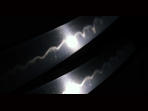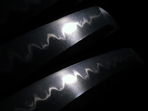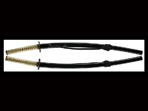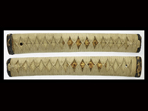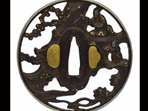Horikawa Kunitake Katana
Horikawa Kunitake is said to be a descendant of Sanjo Yoshinori from the Kyoto-Muromachi period, a student of the master Horikawa Kunihiro, and the father of Izumo Daijo Yoshitake.
Kunitake, was one of the many well-known students of Horikawa Kunihiro. Kunitake is also known to have had a very close relationship with another of Kunihiro’s students Dewa Daijo Kunimichi.
Because the works of Kunitake are so rare, little more is known about him. To get a better feeling for this smith, it would be best to study his teacher, Kunihiro.
Kunihiro is considered by many to be the foremost master of all Shinto sword makers in terms of both his skill and the large number of excellent students who trained under him. In addition, he was one of the most prolific of smiths having produced swords from Tensho 4 (1576) up until the year before he died in Keicho 19 (1614) at the age of 84.
Kunihiro demonstrates two different kinds of workmanship. The first is called his “Tensho-uchi” or “Koyu–uchi” which indicates the style of blades made during his Tensho days of wandering. The second is called “Keicho-uchi” or “Horikawa-uchi” which indicates the blades he made after settling down in the Horikawa section of Kyoto. The “Tensho-uchi” swords show definite traits of Sue-Soshu and Sue- Seki influences. The “Keicho-uchi” or “Horikawa-uchi” swords show strong orthodox Soshu traits of such smiths as Masamune, Sadamune, and Shizu Kaneuji.
This sword is said to be an extremely valuable surviving example by Fujiwara no Kunitake, who lived in Heian Castle. The shape is that of an ancient sword, the base metal features flowing itame hada, and there are some rough forging marks, which are nevertheless worth seeing.
The hamon is a turbulent notare with nie, featuring sunagashi and kinsuji.
The blade has a wide body, thick rim, and deep curvature with an elongated Kissaki.
It´s a fine work of Keicho Shinto with a beautiful shape that was made around the Shoho era ( 1652 ).
This piece also has a sayagaki by Dr. Kunzan, indicating the era as around the Keicho period, with a beautiful shape having a deep curvature and slighty elongated Kissaki.
The Koshira has a black lacquered scabbard. The Tsuba is a Circular iron base surrounded by silver with carved designs of giants, people, and trees, and colored with gold.
The Fuchi Kashira has a high relief dragon design, colored with gold.
The Menuki are large and high relief dragon, colored with gold.
Towards the end of the Muromachi period transitioning into the Edo period around the Keicho era, swordswere made with a solid constructionknow as ´´ Keicho saturation ´´:
Since Heianjyo Kunitake assisted Kunihiro, it is believed he produce fewer works.
However the quallity of his works is exellent, as evidenced by the sayagakiby Dr. Kunzan.
Kunitake sign as:
HEIANJÔ JÛ FUJIWARA KUNITAKE?
KUNITAKE?
FUJIWARA KUNITAKE
This a an etremly rare chance to get a top blade by Horikawa Kunitake.
Horikawa Kunitake Katana - #S0112
Signature: HEIANJÔ JÛ FUJIWARA KUNITAKE
Nagasa: 75.80 cm
Sori: 3.10 cm
Motohaba: 3.09 cm
Motokasane: 0.63 cm
Hamon: turbulent notare with nie, sunagashi and Kinsuji.
Jihada: itame
Paper: NBTHK Tokubetsu Hozon
Koshira: Shirasaya +Katana Koshira
Price: 28500 EUR








